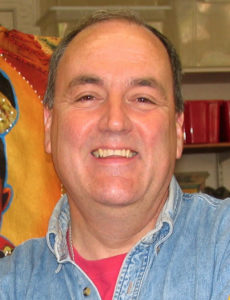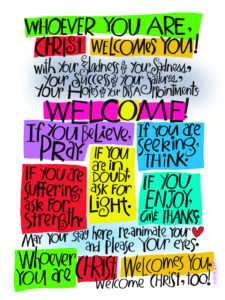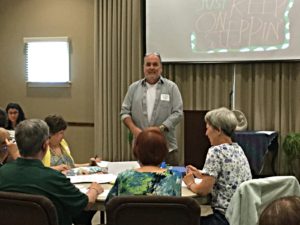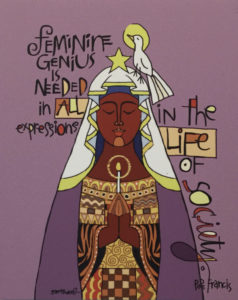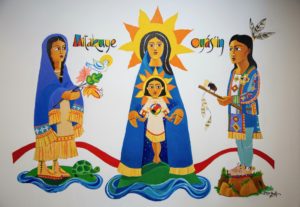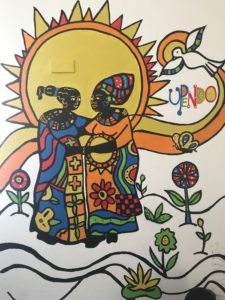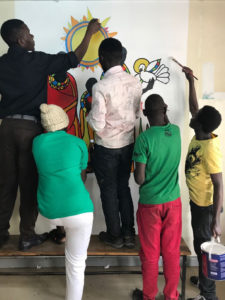Oblate Brother Michael O’Neill McGrath describes himself as a person who likes to paint, write, and tell stories. His life’s motto is a quote from the great Russian author Fyodor Dostoevsky, “Beauty will save the world”. Br. Mickey, as he is most often called, is a popular presenter and frequent keynote speaker at conferences and retreat centers. A Religious Brother in the Oblates of St. Francis de Sales, his award-winning artwork and books are always a delight, spreading his message of the healing power of art, and its ability to bring us together in love and grace.
Interview by Laura Locke
(Click on images to enlarge)
Kolbe Times: So good to have this chance to talk with you today, Br. Mickey – especially in this issue about beauty. May I first say that I love your artwork, and this is a great chance to find out more about what you’ve been up to lately!
Br. Mickey McGrath: Thank you – I’m delighted to be with you today.
Kolbe Times: Let’s begin from the beginning. You were born in Philadelphia and grew up there, is that right?
Br. Mickey McGrath: I did. And now I live in Camden, New Jersey, which is just across the bridge over the Delaware River from Philly. So, I’m still in the same area! But yes, that’s where I grew up. I’m the youngest of five. One of my brothers died of COVID, this past April. He was diabetic and lived in a nursing home, and we buried his ashes on what would have been his 70th birthday, back in September.
Kolbe Times: I’m so sorry to hear that – my condolences.
Br. Mickey McGrath: Thank you. It’s such a crazy time right now, with COVID. It’s a time of letting go, for many people, and in many ways. And that’s where my work hopefully comes in. I’ve been thinking a lot about beauty as a path to healing. Since I can’t travel as I normally do, I’ve been working on drawing some things right here at home around me, like plants and flowers, and the people and places right here in my community. Camden is a very poor town, with a lot of homeless people. Things are improving, but there are still a lot of challenges for many of the people who live here.
Kolbe Times: I think the pandemic is forcing a lot of us to focus on the beauty in our own backyards, and in our own neighbourhoods.
Br. Mickey McGrath: So true. And you know, I’m not minding it! I love traveling – though sometimes I get a little too much of it – but I thought I’d miss the travel a lot more. This COVID thing has forced me to spend more time in my studio, which is nice…plus I’m learning to slow down, and be patient, and all those things that are so important. And being able to Zoom helps. I taught a course for the Catholic Theological Union in Chicago back in June. It was supposed to be live, of course, but doing it virtually has helped me get accustomed to using Zoom. And then I did two webinars for Boston College, and I’m going to do another in January. I love doing things like that – it feels like my old art history teaching days, which I always enjoyed. I’ve been able to bring those two things I love together: the kind of things that I already do when I lead retreats about spirituality and healing and art, and then bringing this art history perspective into it.
Kolbe Times: Has art always been a part of your life? Did your parents encourage it? I’d love to hear more about your early life.
Br. Mickey McGrath: I was very close to my parents. My Mom died when I was 30, and then four years later my Dad died. But some of my earliest memories were from when I was about four years old, and my siblings were all in school at that time – I was the youngest of five kids, as I mentioned – and I remember just my mother and I at home. And I remember how she would do her ironing in the afternoon and watch the soap opera called “As the World Turns”, and I would sit underneath the ironing board and just draw and colour. So I’ve always had this inclination for drawing. Neither of my parents were artistic, but they were very aware of how much I enjoyed it. To this day, I’m very grateful that they enrolled me in art lessons as I got older.
I went to high school run by the community that I’m now a member of – the Oblates of St. Francis de Sales. There were no art classes there, so my parents sent me downtown to the Moore College of Art, an old women’s college in downtown Philly. And that’s where I went every Saturday, for four years all through high school. My parents were very encouraging and nurturing of my love for art. And in fact, after high school I went to Moravian College in Bethlehem, Pennysylvania and majored in art, and then later got my MFA in Painting at the American University in Washington, DC. So, I’m grateful to my parents, and for the experiences I was able to have in both those schools.
Kolbe Times: And then you taught art for a number of years.
Br. Mickey McGrath: Yes, I taught Art and Art History for 11 years at De Sales University in Center Valley, Pennsylvania. And when I was teaching, I often would have students say to me, “Oh, my parents want me to drop art class and take business or marketing or something more useful.” That always made me sad – and I still feel that way. But it makes me even more thankful that I had parents who, you know, respected my interest in art. I’m also thankful that I’m still able to share my love of art and art history with others, especially now with all the struggles we’re having here – the political tensions, and the whole COVID situation.
Kolbe Times: Teaching Art and Art History at the university level must have been an eye-opener for you, and given you a lot of self-confidence as a speaker.
Br. Mickey McGrath: Yes, that’s true. Though, you know, when you’re teaching you don’t have time to do your own art, and after a while I started to really feel that lack in my life. And then right after my parents died, when I was still in my 30s, I definitely started feeling that maybe it was time to move on from teaching. I was just so tired and mentally drained, and I was going through some major changes in my own life. With the deaths of both my parents, I felt like a 35-year-old orphan. I also started to realize that so many of my 19-year-old university students weren’t coming at the topics of Art and Art History from the depths that I was feeling. But you know who did? My older students! They were mostly middle-aged women who were back in school, and they were finding art – whether it was Studio Art or Art History – really wonderful. I’d hear all the time about how much they loved my classes. And something just clicked, and I thought, “This is what I want to do. I want to work with people who really appreciate this stuff.” So I started looking into doing Retreat work, and I never looked back.
But you know, two years ago, I was a Resident Visiting Artist at De Sales where I taught, and I’ve also done Retreats there, and Guest Lectures. And I love that, because it’s just a limited thing. A little while ago a friend of mine who is an English teacher and a poet, who taught there when I did and still teaches there, let me know that he’s doing a course on Beauty. So just last week I was a Guest Lecturer in his class.
Kolbe Times: I also wanted to ask you about how you became a religious Brother with the Oblates of St. Francis de Sales. Can you talk a little about how that all happened?
Br. Mickey McGrath: They were the men who educated me. The high school I attended was run by the Oblates – it was called Father Judge High School in northeast Philly. My father had also gone to an Oblate school, which is now closed, so I grew up hearing about them. I entered right out of high school, which was in 1974. There were 17 of us in that class who entered at that time. We don’t even do that anymore, but that was the norm back then. But I love Salesian spirituality, and Francis de Sales was big on beauty. One of his lines that I quote all the time is, “We pray best before beauty.” When we’re in the presence of beauty, we want to know more about the Creator of all that beauty.
Kolbe Times: I did a bit of reading before our interview about the history and charism of the Oblates, and it does seem very beautiful.
Br. Mickey McGrath: Yes, it’s just timeless stuff. I always think of Francis as the first psychologist because I think he understood the human heart. His whole thing was patience – which I’m finally learning after all these years – and being gentle with yourself. He said that you can’t be gentle with others until you’re gentle with yourself. We put so many expectations on ourselves.
One of my favourite books is Richard Rohr’s “Falling Upward”, which is about the spirituality of the first and second half of life. Now that I’m in that “second half” phase, I keep seeing how much of what he writes is exactly how it’s happened for me. But everything leads me back to St. Francis de Sales. Twelve Steps spirituality, and other recoveries – that’s all very Salesian. Living for each day, the present moment.
Kolbe Times: Those are such wonderful words for right now, with the pandemic – so appropriate and relevant. Trying to live day by day, slowing down, reaching out to others, having empathy. I really enjoyed reading about the life of St. Francis de Sales, and the work that the Oblates are doing around the world.
Br. Mickey McGrath: I wrote a book called Be Who You Are: The Spirit of St. Francis de Sales in Words and Illuminations. That’s one of his mottos that we’ve adopted as a community: “Be who you are, and be that perfectly well.”
Kolbe Times: So here you are now living and working in Camden, and you’ve been there since 2009.
Br. Mickey McGrath: Yes, and I love it. I’ve never been happier. I live at the Immaculate Conception Cathedral Rectory with others in my Oblate Community, and my studio is at a parish in south Camden. It’s not a big town, so it doesn’t take me long to get there. I love being here because it’s taught me to find beauty in places that the world has rejected – seeing beauty in faces and places around me, new expressions of Christ.
Kolbe Times: I just want to say that your art is such a gift, especially during these challenging times of the pandemic. I love the colour, the whimsey, the words that remind us of the wisdom of so many wonderful saints and other inspiring people – your art pieces bring joy and healing and renewed faith to a world that sure needs it right now.
Br. Mickey McGrath: Thank you – that’s lovely of you to say that.
Kolbe Times: How did you develop your style?
Br. Mickey McGrath: Well, I’ve always been a very intuitive thinker and artist. I go in stages. Some artists like to know exactly where they’re headed, before they even get started. That would bore the hell out of me. So, for example, I might come across a quote that I like, and I start with a word from the quote and then build around it – change the font; change the colours as I go. I never know what something is going to look like. And I’ve always been drawn to calligraphy. I never studied it except for a one-week class on formal calligraphy that I took years ago, but I just really like to play with words and the letters.
But the other thing is that now I do a lot of my artwork on my iPad. I’m self-taught on it, largely. It just so happens at the moment that I’m working on two commissions down at my studio, and I’m using real paint and paint brushes. I just hope I can remember how to use them…but I think it’s like riding a bike. But in any event, I really enjoy drawing digitally on my iPad, partly because I realized that I could travel easily with it. So, like, on a long plane trip I can sit and draw the whole time. And the iPad is perfect for doing letters. If you need to change a colour, you just hit a button. You don’t have to start all over again from scratch – it’s amazing. And when you do artwork on the iPad, it can be digitally printed on canvas or whatever.
Kolbe Times: You have talked a bit about how you’ve been exploring Native Spirituality lately. I’d love to hear more about that.
Br. Mickey McGrath: Yes! Back in January 2019 – boy, that seems like a long time ago now – I visited a place called the St. Joseph Indian School in South Dakota. It was a fabulous experience. It’s a boarding school, and there are 200 Native American students attending school there from North and South Dakota. I was there for one week as an Artist in Residence, and every day I would do a mini-workshop for a different group at the school. One day it was for the staff, another day it was for the faculty, one day for the house parents, some of whom were retired couples – though there was also one young couple who had a baby and a four-year-old. During my week there I also created a mural for them. Lots of the students and staff stopped by and helped me paint the mural during the course of the week. The school is right on the Missouri River, and it was really cold there, but really beautiful, too. The river was frozen the whole time. I kind of felt that the landscape was my introduction to the spirit of the Lakota people. Anyways, at the end of the week they asked if I would address the whole school, all 200 kids. I told them that I was going home to New Jersey but that I no longer am considering myself Roman Catholic – I’m now Lakota Catholic. That got a big laugh.
The chief message of the Lakota is that we are all related; “Mitakuye Oyasin” is how they say it. And they don’t just mean people to people, but people to creation, and to all creatures – because our great Creator God created all of us in His image and likeness.
The mural featured the words Mitakuye Oyasin. In the center is Mary and Jesus – and if you look inside her cloak, which is shaped like a teepee, you can see the cosmos. On the left is Kateri Tekakwitha, a remarkable woman who through her father was a member of the Turtle clan of the Mohawk, so that’s why she is pictured with a turtle near her feet; and on the right is Nicholas Black Elk, standing on what is now called Black Elk Peak.
I find the history all so interesting. It was while I was at the school that I learned the story of Nicholas Black Elk. He was a medicine man in the Lakota – amazing man. He had a vision in the Black Hills when he was only nine years old, and it knocked him unconscious for 12 days. He never told anyone about the vision until he was 17 years old. He said that part of the vision was that white people were coming, and they were going to destroy our culture. In his twenties, he was at the Massacre at Wounded Knee, and he helped people who were trying to escape. Later he joined the Buffalo Bill Wild West Show and performed in New York and later in Europe. even performed for Queen Victoria. He wanted to understand white people and their motivations, and try to get to know their culture better. He said, “If they’re going to be our oppressors, I want to understand where they are coming from.” When he returned home, he married a Catholic woman and after her death he became a Catholic himself. He lived until the 1950s…and now he is up for sainthood. The American Bishops started his cause for canonization three years ago. But it makes you wonder, why would he be attracted to the church? I’ve been studying the life of Augustine Tolton, too – the first African American priest, who was born into slavery. So many people, who were oppressed by Christianity…why would they be attracted to it?
What they saw was Christ.
There’s such a difference between Christ and the Church. So many bishops are just clinging to that old all-male dominance, that patriarchal hierarchy. It all means nothing when you look at Christ. You know, the trouble is not so much that people are angry at the Church; it’s that the Church is irrelevant. And that’s a much harder thing to deal with than anger. But I don’t want to ramble – where I was going was that I love this idea of the Lakota people, that we are all related; we are all connected, and there is a ‘oneness’ in all creation. This is what Hildegard of Bingen was saying back in the 12th century, and shortly after her, St. Francis came along with a similar message. It’s what the early Irish Christians were saying, too – “Christ before me, Christ behind me, Christ beneath me, Christ above me.” That’s from St. Patrick’s breastplate prayer, but Black Elk could have written it! It’s a message that’s been here all along, but we’re seeing it now with more nuance. And that’s where I get my excitement and hope.
Kolbe Times: That is hopeful. And I love hearing about your mural project – such a great way to welcome a community to participate in art-making. You’ve worked on a number of other mural projects, too.
Br. Mickey McGrath: Yes, and I love it. It all started in Camden, about six years ago. There’s a homeless shelter called Joseph House here, and I led a project where we painted scenes from the life of St. Joseph. I was leading a Men’s Retreat at Sacred Heart Church in Camden, which is where my studio is. At that time St. Joseph’s house had just recently opened. So I told the guys at the planning meeting for the Retreat that we’re going to do something different: we’re going to paint a mural at this new homeless shelter. Of course a lot of them said, “I can’t paint!” So I basically drew the scenes on the wall myself, and made it like a giant “paint-by-number” colouring book. I had this chart, and it was all numbered on the wall as well. They loved it, and I couldn’t get them out of there. And over the next while college kids and high school kids would come and just paint for a few hours. They all said it made them feel wonderful. I told them that St. Joseph House was feeding the body, because they were giving out hot meals every day – and we were feeding the spirit. One day some of the homeless guests came over and started helping us paint. I think that’s when I realized that I didn’t care if it ever got finished. That’s not the point. It was about prayer and meditation as we painted, and it was about community building – making beauty together.
Kolbe Times: That’s a lovely story.
Br. Mickey McGrath: And then a few years after that I went to Nairobi, Kenya to visit a Maryknoll missionary priest friend, who works at an AIDS Relief Center. I met him originally in New York, and he was telling me about his work in Nairobi. I ended up leading two mural projects at the AIDS Center – one in a women’s clinic and the other in a men’s clinic. It was the most amazing experience, really life-changing for me. The women’s clinic is for pregnant women with HIV. They can meet with doctors and get the medication they need, all for free. They asked me to do a mural in the waiting room, and I thought, “What better image than Mary and Elizabeth – the Visitation.” I thought, even for non-Christians, this is an image of love. In fact, the word “Upendo” is part of the mural, which is the Swahili word for love.
I used the paint-by-numbers idea again in Nairobi. I drew it all out on the wall in chalk, and a Social Worker at the Center named Samson helped me paint the black outlines over the chalk. Samson was so excited to be part of the project because he loves art and in fact uses art a lot in his work. He runs a group for teenagers in Nairobi who are HIV positive. Their mothers didn’t have access to these medications when they were in utero. Anyways, Samson selected seven teenagers, who all had HIV, to come help paint the colours. They just jumped right into it – it became “their” project and they took ownership of it. At one point, Rick said to me, “You have no idea what this means to them because they’re often marginalized at school.” The project turned out to be a healing time for them. We also did a Madonna and Child piece on another wall. It was wonderful. The Holy Spirit directed this entire thing. I had the kids sign their names on the mural at the end of the project.
Kolbe Times: You also did a mural in New York recently.
Br. Mickey McGrath: Yes, that was in 2019 as well, in the St. Francis de Sales Church in New York City. They asked for a mural because they had recently redone their church basement. It was August, so the kids weren’t back in school yet, so there were lots of kids helping out as well as adults. It was kind of a neighbourhood outreach program, and also an ecumenical outreach – I remember a United Church of Christ pastor and his wife from the neighbourhood helped us out. We put a quote from Dorothy Day on one of the walls: “If we could only learn that the only important thing is to love and to show that love and express that love over and over, whether we feel it or not, 70 X 7, not do anything but love…” She, of course, was also a New Yorker, and is known for her social activism and as co-founder of the Catholic Worker Movement.
There were also lots of columns in this big basement space, so we painted on them, too – we painted the word “love” in all the languages represented in the parish on the columns. It was all very simple, but with lots of bold shapes. A great experience.
And in early 2020 I also painted a mural in one of our Oblate parishes in Reston, Virginia called St. John Neumann Church. They wanted a quote too, so I did the design and drawing. Then the painting began, with the help of volunteers from the church and also some guests who were staying at the Church as part of the County’s annual hypothermia program, where churches in the area offer hospitality and food and a warm place to sleep to people who need it. We painted this quote from St. Francis de Sales: “We should hide our littleness in God’s greatness and stay there like a little bird, beneath its mother’s sheltering wing.” I didn’t realize until later, but the mural is in a hallway where preschoolers and their parents pass by every day. So it turned out to be perfect, because the mural has mother birds and baby birds, and nests and feathers.
Kolbe Times: Aww, that’s wonderful. I love visiting your website. It’s just full of beautiful examples of your artwork and creations – books you’ve written and illustrated, as well as things like your colouring books and posters. And I noticed that a few years ago you started leading Art & Faith tours to various places in Europe…that sounds fantastic!
Br. Mickey McGrath: Yes, those have been great fun. I love taking people to places where the art is really significant, and to share my love of Art History. Last year we went to Bingen, in Germany and explored the beautiful part of the world where Hildegard of Bingen lived, and then we spent some time in Cologne, with its amazing medieval churches and all its art galleries. We were planning a trip to Spain this past September, to see all the spiritual and historical treasures there, but of course that had to be put on hold.
Kolbe Times: I appreciate all the ways you have found to share your art with the world, and how you bring your faith and your love for people into everything you do. You’ve had a relationship with beauty for a long time. It’s been like a thread throughout your life.
Br. Mickey McGrath: Well, you, know everybody loves beauty, no matter what faith tradition you come from. And I guess art just comes naturally to me. I was very shy as a kid, and that was one of the reasons my parents set up a little art studio for me in our basement at home. That’s where I would go every day when I got home from school. But I think you’re right – beauty has somehow been a thread throughout my life, and I’m very grateful for it. Pope Paul VI once said, “It is beauty, like truth, which brings joy to the heart.”
Kolbe Times: Br. Mickey, it’s been a joy talking with you today. Thank you for sharing your stories with us.
Br. Mickey McGrath: It’s been my pleasure. And thank you for Kolbe Times.
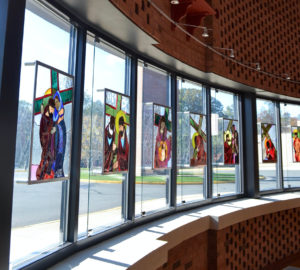
Stations of the Cross, based on drawings by Br. Mickey, in the chapel of Our Lady of Good Council Church in Vienna, Virginia
Visit Br. Mickey’s website for more about his art, books and other upcoming projects, and follow him on Facebook.
All images courtesy of Br. Mickey McGrath.


